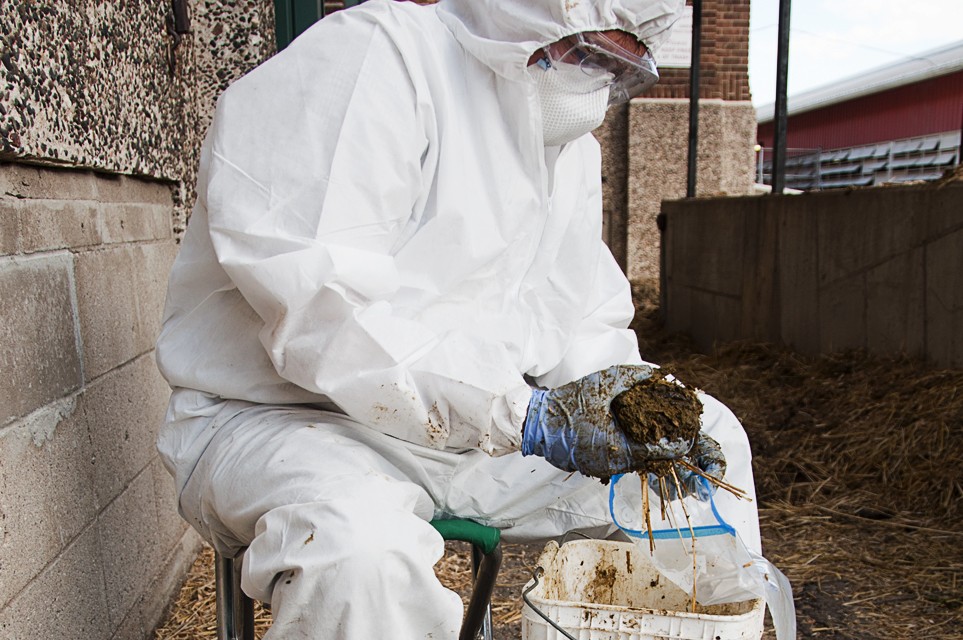Taking advantage of the variety of food offered annually at the Minnesota State Fair, researchers obtained waste samples in hopes of creating a new type of soup âÄî manure soup that is.
Fortunately, this special type of soup is not intended for human consumption, although it may play a major role in benefiting the University of Minnesota in the future.
The so-called âÄúsoupâÄù is part of a project called the âÄúWaste-to-EnergyâÄù study, a collaboration between MinnesotaâÄôs largest engineering services firm, Short Elliot Hendrickson (SEH), the Fair and the University.
During each of the 12 days of the Fair, SEH environmental scientist George Johnson, protected by a biohazard suit, traveled around the fair collecting samples of manure and organic food waste, later to be analyzed for composition, quality and quantity.
If the samples meet requirements, the waste from the fair could be combined with organic waste from the UniversityâÄôs St. Paul campus and converted to energy, Johnson said.
The key to turning manure and organic wastes into energy is in the recipe.
In the past, many livestock operations, such as chicken or swine farms, have tried to use their livestockâÄôs waste to generate energy, Johnson said, which works to a point.
Methane and biogases are produced by entirely different sets of populations of microorganisms, Johnson said. When you mix the different kinds of manures and organic waste together, you actually get a better effect and higher production rate.
âÄúMaking methane is really a lot like making a soup or stew,âÄù he said, âÄúyou take all the ingredients, you put them in a big pot, cook them at the right temperature for the right amount of time, and you can think of the methane as the luxurious, aromatic steam rising off.âÄù
The hope is that the organic waste combination will eventually be converted into a natural gas that could offset energy costs for the St. Paul campus.
âÄúThe project is in its very early stages, kind of its infancy,âÄù said Ed Welsch, facilities coordinator.
The end goal is that the University will be able to construct an anaerobic digester âÄî âÄúlike a pot or a pressure cooker,âÄù Johnson said âÄî that would take methane from the different manure samples, filter it and then burn it to make electricity.
The effort to turn organic wastes into energy started about five years ago when the University looked into the possibility of making the St. Paul campus more sustainable, said Johnson, a University alumnus. The results showed that there wasnâÄôt enough waste material coming out of the St. Paul campus on a day-to-day basis to justify building a system to convert it.
The Fair, on the other hand, produces a large amount of waste in a little amount of time.
âÄúWeâÄôre not talking about just the 12 days of the fair,âÄù Welsh, said. âÄúWeâÄôre talking about covering the whole thing âÄî the State Fair is just the big blip in the whole year.âÄù
The Minnesota Horse Expo, the Minnesota Beef Expo and other livestock events held annually at the fairgrounds are events in which manure has the potential to be combined with St. PaulâÄôs organic waste and converted to energy.
Because of the sporadic timing of events held at the fairgrounds, the waste-stream, or amount of waste produced, is what Johnson calls âÄúflashy.âÄù
âÄúIt peaks, and then it drops, then peaks again and repeats, whereas the waste-stream on campus is fairly regular,âÄù Johnson said. âÄúIt has a much gentler curve.âÄù
When the two waste-streams are combined, the result is a much more even flow of waste, Welsch said.
Both Johnson and Welsch agree that the next step in the project is to conduct a comprehensive feasibility study on the St. Paul campus and create a model that can be viewed by the public to gain support, Welsch said.
The researchers have to find the money to go forward with the project.
âÄúThereâÄôs a little bit of a bump because of the minor recession weâÄôre in now,âÄù Johnson said.
Even without funding for the next step, researchers took samples at the fair because it is a major waste producer that happens only once a year. The samples are stored in a lab on the St. Paul campus.
Researchers are currently applying for grants. Once the projectâÄôs future is secured financially, there are several departments on campus looking to have a part in the study, including animal science and bioproducts and biosystems engineering.
Jim Linn, head of the Department of Animal Science said, âÄúWe certainly hope to be involved from a research and educational component, but at this time, it is so premature that we really havenâÄôt been involved.âÄù
SEH and the University hope that if all goes well, the energy may be converted to natural gas and sold to Xcel Energy to offset cooling and heating costs for some of the older buildings on the St. Paul campus, Welsch said.
Should the project move forward, a research lab built along with the anaerobic digester would give masterâÄôs students an opportunity to conduct research at the facility, Welsch said.
âÄúBiomass and bioenergy [from methane gas] has never been the sexiest part of renewable energy,âÄù Johnson said. âÄúA lot of people talk about wind, solar cells and hydro power, and those things are all good and important tools too, but this is a technology that works, and now it needs to be brought up one more level of size âĦ [The St. Paul campus] is the perfect place to do it.âÄù

Image by Jason Kopp
George Johnson, of Short Elliott Hendrickson Inc., mixes and bags samples of cow manure at the Fair Saturday. He is part of a team researching the energy potential of these waste products for the University and the State Fair.
Fair waste tested as U’s clean energy
Researchers are looking to turn the organic compounds into natural gas.
by Ashley Bray
Published September 9, 2010
0
More to Discover







